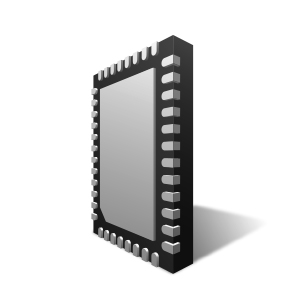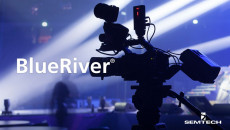GS6152
This product has reached its End of Life. Its data sheet is for reference only.
The GS6152 is a low-power, multi-rate serial digital reclocker designed to automatically recover the embedded clock from a digital video signal with reduced jitter and sample the incoming video data with the clean clock.Features
- SMPTE ST 2081, ST 424, ST 292, and ST 259-C compliant
- Supports reclocking data at rates of 125Mb/s, 270Mb/s, 1.485 and 1.485/1.001Gb/s, 2.97 and 2.97/1.001Gb/s, 5.94 and 5.94/1.001Gb/s
- Supports reclocking of DVB-ASI signals
- Automatic or Manual Rate Selection
- Detected rate indication in Auto Mode
- 4:1 input selector patented technology
- Two reclocked data outputs
- Four configurable GPIO pins with ability to output device status, including:
- Lock Detect
- Loss of Signal (LOS)
- Low/High bit-rate indication for slew-rate control of SDI cable drivers
- On-chip 100ohm differential input and output termination
- Bypass support for rates up to 5940Mb/s
- Manual Bypass function
- Configurable automatic Bypass when not locked
- Option to use external reference or operate referenceless
- Cascading reference buffer supports multiple reclockers using a single reference source
- Input signal equalization and output signal de-emphasis to compensate for trace dielectric losses
- Single power supply operation at 1.8V
- 130mW typical power consumption (150mW with second output enabled)
- Pb-free and RoHS compliant
- Operating temperature range: -40°C to 85°C
- SMPTE ST 2081, SMPTE ST 424, SMPTE ST 292, SMPTE ST 259-C coaxial cable serial digital interfaces
- EN50083-9 DVB-ASI interfaces
- MADI standard
Applications
Order Codes
- GS6152-INE3: Lead-Free, RoHS Compliant, Tray-490 Pieces
- GS6152-INTE3: Lead-Free, RoHS Compliant, Tape and Reel-250 Pieces
- GS6152-INTE3Z: Lead-Free, RoHS Compliant, Tape and Reel-2500 Pieces
Pb(Lead)-Free/RoHS-Green Info
(-40°C to +85°C / 4000 cycles)
(50°C, 4000 Hrs)
Datasheets & Documentation
Explore a wealth of downloadable resources and datasheets to assist with prototyping and production.
Login or register for mySemtech to gain access to restricted product documentation and to add documents to your Watch List for update alerts
Inventory
| Product | Country | Distributor | Qty | Buy |
|---|
Resources
To see more videos Videos
In this fifth and final installment of the BlueRiver applications blog series, we’ll look at how two Semtech products lines – Semtech’s BlueRiver® ASIC platform for Pro AV and SDVoE™, and broadcast Serial Digital Interface (SDI) – can enable a unique set of “SDI-over-IP” products and applications.
BlueRiver® Applications Part 5: BlueRiver &…
READ NOWWhether you are watching an action replay of a baseball game on a giant screen at a stadium, a movie on your large-screen TV or streaming a video on your laptop computer, a high-quality audiovisual (AV) experience is always expected. Ultra-High-Definition Serial Digital Interface (UHD-SDI) and High-Definition Multimedia Interface (HDMI) are two standards for digital AV transmission. UHD-SDI standardizes the transmission of uncompressed and unencrypted digital AV signals over coaxial or fiber optic cables. HDMI is a digital interface for transmitting high-definition, high-speed digital multi-track audio and uncompressed video signals from HDMI-compliant sources to AV displays. Even though they both can transport ultra-high-definition AV signals from a source to a display, HDMI is preferred to connect consumer gadgets such as computers, gaming consoles, Blu-ray/DVD players, televisions, projectors, etc. UHD-SDI is preferred for high-end applications such as professional indoor/outdoor video production and television broadcasts because it supports long-range transmission and a rugged connection with the help of a physical lock mechanism at each end of the cable. UHD-SDI coaxial cable can transfer signals up to 300 feet, whereas HDMI cables struggle with excessive signal degradation even within 50 feet. These two interfaces can be used together via an HDMI-SDI or SDI-HDMI converter. For example, as shown in figure 1, an HDMI display would be used for confidence monitoring of an SDI stream to avoid the need to use specially calibrated SDI-specific displays.
Circuit Protection for HDMI-SDI/SDI-HDMI…
READ NOWI designed my first product using the Serial Digital Interface (SDI) back in 1996, and little did I know that this fledgling coax-based video interface standard would dominate my career for the next 20+ years. Back then, SDI was limited to carrying Standard Definition (SD) digital video at 270 Megabits per second (Mbps), but would evolve to higher and higher data rates to carry High Definition 720p, 1080i and 1080p, and most recently 4K Ultra High Definition (UHD) video, at cable lengths that were not thought possible. The convenience of a low cost single conductor coaxial copper cable, capable of carrying 4K video up to 100m has meant that SDI has become the de facto AV connectivity of choice in markets such as broadcast, Pro AV, medical and surveillance.
Serial Digital Interface Is Dead: Long Live SDI!
READ NOW



